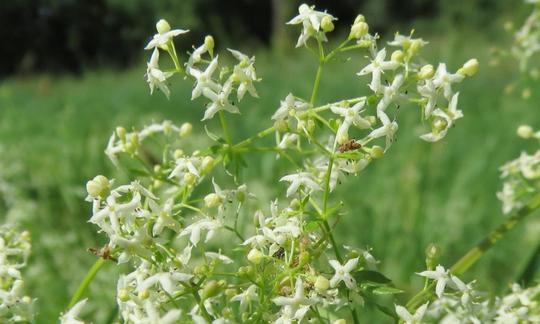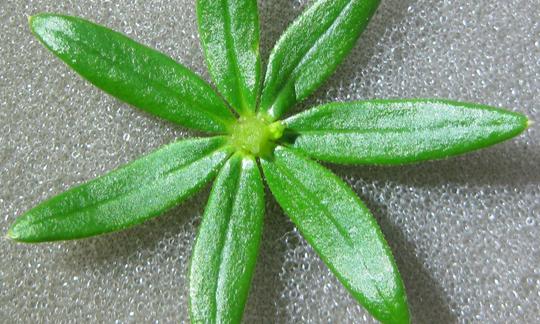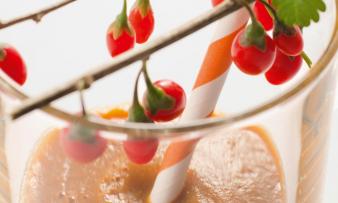Table of contents
Meadow bedstraw ( Galium mollugo) is a popular wild plant that can be used in many different ways in the kitchen, even raw. Today, it plays a minor role as a medicinal plant.
Use in the kitchen:
There are many different uses for meadow bedstraw in the kitchen. The basic taste of the young plant is reminiscent of a mixture of mildlettuce, kale and rocket. 1,2 The ingredient coumarin is responsible for the sweet hay smell of the drying leaves. 3
The young shoots and flowers of the meadowsweet are suitable for soups, raw pestos, raw food smoothies, sauces, chopped herb mixtures, leafy vegetable dishes, spinach or as a nutty salad base. 2
The sweet, honey-scented flowers are a popular flavor for drinks and herbal lemonades. The flowers can be used to decorate dishes or to make jelly, syrup, flower pudding and other desserts. 2
Sprouts can be grown from the seeds of the meadowsweet in winter. The small seeds can be roasted and used as a coffee substitute. 2
In a wild herb smoothie, meadowsweet tastes great combined with chickweed, nettle and winter cress - alternatively, you can also use watercress or nasturtium.
An aromatic wild plant salad can be prepared from apples, nuts, ribwort, dandelion and meadowsweet. 4
Vegan recipe for herbal smoothie with meadow bedstraw:
For the herbal smoothie, cut two apples (with the core and stalk removed) and 200 g of peeled celeriac into large pieces and puree them together with 4 dates, 3 tbsp goji berries (fresh or dried - then soaked beforehand), 5 g meadow bedstraw, 5 g cinquefoil, 1 tbsp lime juice and water. Add enough water until you get a drinkable but not too runny consistency. You can find the full recipe description HERE.
Recipe for (fresh) bedstraw tea:
To make bedstraw tea, pour boiling water over 4-5 g of finely chopped bedstraw (2 heaped teaspoons; 1 teaspoon = approx. 1.7 g). After letting it steep for 10 minutes, strain the infusion through a sieve. You can also brew the bedstraw with cold water and then bring it to the boil. 5
| Not only vegans or vegetarians should read this: Vegans often eat unhealthily. Avoidable nutritional errors. |
Purchasing - where to buy?
Meadow bedstraw ( Galium mollugo and Galium album = Galium mollugo agg.) can be purchased as seeds or seedlings in specialist shops and online.
Bedstraw tea is available in bulk. It is usually not meadow bedstraw, but true bedstraw ( Galium verum). Bedstraw products are not very common. There is an ointment (no further information on the type of bedstraw), a bedstraw tincture ( Galium verum) and a liquid extract with burdock bedstraw ( Galium aparine) available on the market.
We have not yet found any products containing meadowsweet in supermarkets and discount stores such as Coop, Migros, Denner, Volg, Spar, Aldi, Lidl, Rewe, Edeka or Hofer, nor in the organic supermarkets Denns and Alnatura.
Found in the wild - Season:
Together with the white bedstraw ( Galium album), the meadow bedstraw ( Galium mollugo) forms the species group Galium mollugo agg. 1
Where can you find bedstraw? This species is widespread and common in Central Europe. Meadow bedstraw grows on moist, nutrient-rich and loamy soils. The wild plant, which does not tolerate much shade, prefers bright locations such as forest clearings, path and forest edges, as well as sunny pastures and (mountain) meadows. 1
The meadow bedstraw, which can grow up to one meter tall, is a summer green and herbaceous wild plant. The bare, square stem has whorls of leaves from which secondary branches branch off. The whorls of leaves usually consist of eight lanceolate individual leaves. The grape-shaped inflorescences are located at the tips of the main and secondary stems. The flowers of the meadow bedstraw have a diameter of 2 to 3 mm. The flowers of the collective species are white and have four rays. 1
The main flowering period of the meadow bedstraw is from May to September. Season : In spring, the thick, juicy and very mild shoots are harvested as they sprout. From May to September, the flowers and flower buds can be picked. In August and September, the small seeds are collected from the herb and in winter, small, juicy shoots can be found under the snow cover. 2
Storage:
To dry, hang fresh bedstraw in small bunches in a dry and airy place. The dried flowers and leaves can be pulled off the stem and stored in aroma-protecting bags, dark glass jars or metal tins.
Ingredients - Nutritional value - Calories:
Bedstraw contains glycosides, small amounts of alkaloids, tannins, essential oil 2 and asperuloside (a glycosidic component) from which coumarin is formed. 3
Health aspects - effects:
The human body can convert the active ingredient asperuloside into prostaglandins. These are hormone-like compounds that stimulate uterine functions and can affect the blood vessels. 3
Pharmacological studies on coumarins have shown anti-inflammatory, antioxidant, anti-allergic, hepatoprotective, antithrombotic, antiviral and antitumor properties, among others. The therapeutic use of coumarin includes the treatment of lymphedema and chronic venous insufficiency. 6
The use of chemically synthetic 4-hydroxycoumarin compounds to inhibit blood coagulation and to treat thrombosis is widespread. 6
Please note that the statements on effectiveness refer to isolated active ingredients and not to studies on the effectiveness of meadowsweet.
Dangers - Intolerances - Side effects:
When taking high doses of coumarin, undesirable side effects such as dizziness, nausea, diarrhea and vomiting have been observed. Liver dysfunction and liver toxic effects are rare. Clinical data show that liver dysfunction can occur in individual cases during treatment with preparations containing coumarin. However, the effect of high coumarin intake is reversible and the liver recovers within a few weeks. No permanent damage has been observed. New scientific findings show that the substance does not change the genetic material (DNA). 6,7
Is bedstraw poisonous? Meadow bedstraw contains variable amounts of asperuloside, which is used in the body to produce coumarin. Moderate consumption should not cause any negative side effects in healthy people.
Coumarin is a secondary plant compound that occurs naturally in numerous plant species. Small amounts are found in foods such as apricots, blackberries, strawberries, dates, cherries, and in garden herbs such as sage, dill, and chamomile. 6 Cassia cinnamon has fallen into disrepute because of its high coumarin content. Ceylon cinnamon, on the other hand, is a low-coumarin alternative. Coumarin is also found in woodruff ( Galium odoratum), sweet clover ( Melilotus), tonka beans, and peppermint oil.
Foods must not contain any added, isolated coumarin. The limit for coumarin found in spices is 2 mg/kg of food. The TDI (Tolerable Daily Intake) value is set at 0.1 mg/kg of body weight. For an adult, the maximum amount is therefore 6 mg per day. 7
Due to insufficient data, pregnant women, breastfeeding women and children under 12 years of age should discuss the use of (meadow) bedstraw with a specialist.
Use as a medicinal plant:
What is bedstraw good for? To date, there are no monographs on meadow bedstraw from the Committee on Herbal Medicinal Products ( HMPC), the umbrella organization of national European societies for phytotherapy ( ESCOP / European Scientific Cooperative on Phytotherapy) or from Commission E (independent, scientific expert commission for herbal medicinal products of the current Federal Institute for Drugs and Medical Devices ( BfArM) in Germany).
The common bedstraw ( Galium verum) also has no recognized medical applications to date. Only the quality of the common bedstraw is specified in the German Drug Codex ( DAC). 5,8
What is bedstraw tea good for? Since the healing effects of bedstraw have not yet been proven, its medical use cannot currently be recommended from the perspective of modern herbal medicine. 9
Folk medicine - natural medicine:
In folk medicine, meadowsweet is used to stimulate the activity of the kidneys and lymph. It is hoped that its use will have a blood-cleansing and diuretic effect and will provide relief from kidney stone problems. The plant, which is said to awaken the spirits, is also used for ulcers. 2
Occurrence - Origin:
Meadow bedstraw ( Galium mollugo) and white bedstraw ( Galium album) are closely related and, as mentioned above, form the species group Galium mollugo agg. However, they differ in their chromosomes. Galium mollugo is much rarer in Central Europe than Galium album. Any information about Galium mollugo must first be checked to see whether it applies to this specific species. The term meadow bedstraw can generally only refer to the species group. 1
Growing in the garden or as a potted plant:
Meadow bedstraw can be grown in the garden or as a potted plant. The location should be sunny to partially shaded and the soil nutrient-rich, fresh and loamy. Propagation occurs through division or self-seeding. The above-ground parts of the plant usually die in late winter, but the herb can also remain green. The root is frost-hardy. Meadow bedstraw requires no care. 1.10
Danger of confusion:
Within the collective species Galium mollugo agg. there can be confusion. 1 Before flowering, the white-flowering meadow bedstraw can be confused with the yellow-flowering common bedstraw ( Galium verum). 4 There is no real danger of confusion, as these bedstraw species are edible and can be used in a similar way. To avoid confusion, you can work with profiles, pictures and drawings of the bedstraw species.
Animal protection - species protection - animal welfare:
The pollination of meadow bedstraw flowers is usually carried out by short-nosed insects, especially bees, but also by flies and beetles. Meadow bedstraw is a popular food plant for many butterfly caterpillars such as hummingbird hawk moths, vine hawk moths, purple bear moths, bedstraw hawk moths, various geometer moths and owl butterflies. 1.10
General information:
The genus Galium includes more than 600 species and belongs to the Rubiaceae family. 1
Meadow bedstraw ( Galium mollugo) is a plant species of the bedstraw family and together with Galium album forms the species group Galium mollugo agg. 1
Other species widespread in Europe are the true bedstraw ( Galium verum), also called yellow wood straw, lady's bedstraw, sweet herb, jointed herb or yellow bedstraw, and the common bedstraw ( Galium aparine).
According to Wikipedia, the name bedstraw comes from its use as an acidifier in cheese production. The scientific name Galium (from the Greek gala = milk) is also derived from this. 12
Alternative names:
There are regionally used alternative names and spellings for meadow bedstraw, bedstraw, small meadow bedstraw, common bedstraw, megerkraut, white forest straw, butterstiel (Tübingen), Liebfrauenstroh (Carinthia), star megerkraut, oarkreutl (Tyrol in Pinzgau), Littgängche (Eifel), Gliedekraut (Silesia), grass star, wild redness, soite Klei (Göttingen) or narrow star. 1
In English, meadowsweet is called false baby's breath or hedge bedstraw.
Keywords for use:
The roots of Galium mollugo agg. and all Galium species were formerly used to produce red dye for textiles. Galium species contain rennet, which is still used in traditional cheese production. Farmers fight meadow bedstraw because too high a proportion in hay is considered inferior. 1,12
Literature - Sources:
Bibliography - 10 Sources
| 1. | Wikipedia Wiesen-Labkraut. |
| 2. | Fleischhauer S. G., Guthmann J., Spiegelberger R. Enzyklopädie. Essbare Wildpflanzen. 2000 Pflanzen Mitteleuropas. 1. Auflage. Aarau; 2013. AT Verlag. |
| 3. | Bown D. Kräuter. Die grosse Enzyklopädie. Anbau und Verwendung. 2. Auflage. München; 2015. Dorling Kindersly. |
| 4. | bzfe.de Wiesenlabkraut. |
| 5. | Blaschek W. (Herausgeber). Wichtl –Teedrogen und Phytopharmaka. Ein Handbuch für die Praxis. 6. Auflage. Stuttgart; 2016. Wissenschaftliche Verlagsgesellschaft mbH. |
| 6. | pharmazeutische-zeitung.de Cumarin. Gesundheitsrisiko nicht auszuschliessen. |
| 7. | pharmazeutische-zeitung.de Differenzierte Risikobetrachtung. Cumarine in pflanzlichen Arzneimitteln. |
| 8. | arzneipflanzenlexikon.info Labkraut. Echtes Labkraut – Galium verum L. |
| 9. | Niederegger O., Mayr C. Heilpflanzen der Alpen. Gesundheit aus der Natur von A bis Z. Innsbruck; 2006. Tyrolia-Verlag. |
| 12. | Wikipedia Labkräuter. |








Comments